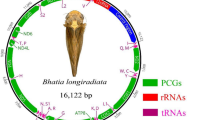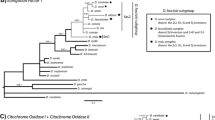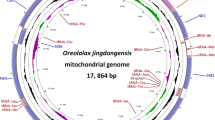Abstract
Approximately 2 kb corresponding to different regions of the mtDNA of 14 different species of the obscura group of Drosophila have been sequenced. In spite of the uncertainties arising in the phylogenetic reconstruction due to a restrictive selection toward a high mtDNA A+T content, all the phylogenetic analysis carried out clearly indicate that the obscura group is formed by, at least, four well-defined lineages that would have appeared as the consequence of a rapid phyletic radiation. Two of the lineages correspond to monophyletic subgroups (i.e., afftnis and pseudoobscura), whereas the obscura subgroup remains heterogeneous assemblage that could be reasonably subdivided into at least two complexes (i.e., subobscura and obscura).
Similar content being viewed by others
References
Afonso JM, Pestano J, Hernández M (1988) Rapid isolation of mitochrondrial DNA from Drosophila adults. Biochem Genet 26: 381–386
Barrio E, Latorre A, Moya A, Ayala FJ (1992) Phylogenetic reconstruction of the Drosophila obscura group based on mitochondrial DNA. Mol Biol Evol 9:621–635
Beckenbach AT, Wei YW, Liu H (1993) Relationships in the Drosophila obscura species group, inferred from mitochondrial cytochrome oxidase II sequences. Mol Biol Evol 10:619–634
Brehm A, Krimbas CB (1990) The phylogeny of nine species of the Drosophila obscura group inferred by the banding homologies of chromosomal regions. II. Element E. Hereditas 113:157–168
Brehm A, Krimbas CB (1992) The phylogeny of nine species of the Drosophila obscura group inferred by the banding homologies of chromosomal regions. III. Element D. Genome 35:1075–1085
Brehm A, Krimbas CB (1993) The phylogeny of nine species of the Drosophila obscura group inferred by the banding homologies of chromosomal regions. IV. Element C. Heredity 70:214–220
Brehm A, Krimbas CB, Sourdis J, Cariou ML (1991) The phylogeny of nine species of the Drosophila obscura group inferred by the banding homologies of chromosomal regions. I. Element B. Genome 34:464–471
Brown WM, Prager EM, Wang A, Wilson AC (1982) Mitochondrial DNA sequences of primates: tempo and mode of evolution. J Mol Evol 18:225–239
Buzzati-Traverso A, Scossiroli RE (1955) The obscura group of the genus Drosophila. Adv Gent 7:47–92
Cabrera VM, González AM, Larruga JM, Gullón A (1983) Genetic distance and evolutionary relationships in the Drosophila obscura group. Evolution 37:675–689
Cariou ML, Lachaise D, Tsacas L, Sourdis J, Krimbas C, Ashburner M (1988) New African species in the Drosophila obscura species group: genetic variation, differentiation and evolution. Heredity 61: 73–84
Clary DO, Wolstenholme DR (1985) The mitochondrial DNA molecule of Drosophila yakuba: nucleotide sequence, gene organization, and genetic code. J Mol Evol 22:252–271
Cracraft J, Helm-Bychowski K (1991) Parsimony and phylogenetic inference using DNA sequences: some methodological strategies. In: Miyamoto MM, Cracraft J (eds) Phylogenetic analysis of DNA sequences. Oxford University Press, New York, pp 184–220
DeSalle R, Freedman T, Prager EM, Wilson AC (1987) Tempo and mode of sequence evolution in mitochondrial DNA of Hawaiian Drosophila. J Mol Evol 26:157–164
Dobzhansky T, Powell JR (1975) Drosophila pseudoobscura and its American relatives, Drosophila persimilis and Drosophila miranda, vol 3. In: King RC (ed) Handbook of genetics. Plenum Press, NY, pp 537–587
Felsenstein J (1981) Evolutionary trees from DNA sequences: a maximum likelihood approach. J Mol Evol 17:368–376
Felsenstein J (1985a) Confidence limits on phylogenies with a molecular clock. Syst Zool 34:152–161
Felsenstein J (1985b) Confidence limits on phylogenies: an approach using the bootstrap. Evolution 39:783–791
Felsenstein J (1990) PHYLIP manual version 3.3. University Herbarium of the University of California, Berkeley
Fitch WM (1971) Toward defining the course of evolution: minimum change for a specified tree topology. Syst Zool 20:406–416
Garesse R (1988) Drosophila melanogaster mitochondrial DNA: gene organization and evolutionary considerations. Genetics 118:649–663
Goddard K, Caccone A, Powell JR (1990) Evolutionary implications of DNA divergence in the Drosophila obscura group. Evolution 44: 1656–1670
González AM, Hernández M, Volz A, Pestano J, Larruga JM, Sperlich D, Cabrera VM (1990) mitochondrial DNA evolution in the obscura species subgroup of Drosophila. J Mol Evol 31:122–131
Higgins DG, Sharp PM (1988) CLUSTAL: a package for performing multiple sequence alignment on a microcomputer. Gene 73:237–244
Hillis DM, Bull JJ (1993) An empirical test of bootstrapping as a method for assessing confidence in phylogenetic analysis. Syst Biol 42:182–192
Kishino H, Hasegawa M (1989) Evaluation of the maximum likelihood estimate on the evolutionary tree topologies from DNA sequence data, and the branching order in Hominoidea. J Mol Evol 29:170–179
Kraus F, Miyamoto MM (1991) Rapid cladogenesis among the Pecoran ruminants: evidence from mitochondrial DNA sequences. Syst Zool 40:117–130
Krimbas K, Loukas M (1980) The inversion polymorphism of Drosophila subobscura. Evol Biol 12:163–234
Krimbas K, Loukas M (1984) Evolution of the obscura group Drosophila species. I. Salivary chromosomes and quantitative characters in D. subobscura and two closely related species. Heredity 53:469482
Kumar S, Tamura K, Nei M (1993) MEGA: molecular evolutionary genetics analysis, version 1.0. The Pennsylvania State University, University Park, Pennsylvania
Lakovaara S, Keränen L (1980) Phylogeny of the Drosophila obscura group. Genetika 12:157–172
Lakovaara S, Saura A (1982) Evolution and speciation in the Drosophila obscura group. In: Ashburner M, Carson HL, Thompson JN (eds) The genetics and biology of Drosophila, vol 36. Academic Press, New York, pp 1–59
Lakovaara S, Saura A, Falk CT (1972) Genetic distance and evolutionary relationships in the Drosophila obscura group. Evolution 26: 177–184
Lakovaara S, Saura A, Lankinen P, Pohjola L, Lokki J (1976) The use of isoenzymes in tracing evolution and in classifying Drosophilidae. Zool Scripta 5:173–179
Latorre A, Barrio E, Moya A, Ayala FJ (1988) Mitochondrial DNA evolution in the Drosophila obscura group. Mol Biol Evol 5:717–728
Latorre A, Moya A, Ayala FJ (1986) Evolution of mitochondrial DNA in Drosophila subobscura. Proc Natl Acad Sci USA 83:8649–8653
Li W-H, Gouy M (1990) Statistical tests of molecular phylogenies. Methods Enzymol 183:645–659
Liu H, Beckenbach AT (1992) Evolution of the mitochondrial cytochrome oxidase II gene among 10 orders of insects. Mol Phylogenet Evol 1:41–52
Loukas M, Krimbas CB, Vergini V (1984) Evolution of the obscura group Drosophila species: II. Phylogeny of ten species based on electrophoretic data. Heredity 53:483–493
Marfany G, Gonzàlez-Duarte R (1993) Characterization and evolution of the Adh genomic region in Drosophila guanche and Drosophila madeirensis. Mol Phylogenet Evol 2:13–22
Marinkovic D, Ayala FJ, Andjelkovic M (1978) Genetic polymorphism and phylogeny of Drosophila subobscura. Evolution 32:164–173
Martin AP, Kessing BD, Palumbi SR (1990) Accuracy of estimating genetic distance between species from short sequences of mitochondrial DNA. Mol Biol Evol 7:485–488
Martínez D, Moya A, Latorre A, Fereres A (1992) Mitochondrial DNA variation in Rhopalosiphum padi (Homoptera: Aphididae) populations from four distant Spanish localities. Ann Entomol Soc Am 85:241–246
Pamilo P, Nei M (1988) Relationships between gene trees and species tress. Mol Biol Evol 5:568–583
Pinsker W, Buruga J (1982) Comparative study of allozyme variation in six species of the Drosophila obscura group. Z Zool Syst Evolutionsforsch 20:53–63
Ruttkay H, Solignac M, Sperlich D (1992) Nuclear and mitochondrial ribosomal RNA variability in the obscura group of Drosophila. Genetica 85:131–138
Saccone C, Lanave C, Pesole G (1993) Time and biosequences. J Mol Evol 37:154–159
Saitou N, Nei M (1987) The neighbor-joining method: a new method for reconstructing phylogenetic trees. Mol Biol Evol 4:406–425
Sambrook J, Fritsch EF, Maniatis T (1989) Molecular cloning. A laboratory manual. Cold Spring Harbor Laboratory Press, New York
Sanger F, Nicklen S, Coulson AR (1977) DNA sequencing with chain-terminating inhibitors. Proc Natl Acad Sci USA 74:5463–5467
Sturtevant AH (1942) The classification of the genus Drosophila with the description of nine new species. Univ Texas Publ 4213:5–51
Swofford DL, Olsen GJ (1990) Phylogenetic reconstruction. In: Hillis DM, Moritz C (eds) Molecular systematics. Sinauer, Sunderland, MA, pp 411–501
Tamura K (1992a) Estimation of the number of nucleotide substitutions when there are strong transition-transversion and G+C-content biases. Mol Biol Evol 9:678–687
Tamura K (1992b) The rate and pattern of nucleotide substitution in Drosophila mitochondrial DNA. Mol Biol Evol 9:814–825
Templeton AR (1983) Phylogenetic inference from restriction endonuclease cleavage site maps with particular reference to the evolution of humans and the apes. Evolution 37:221–224
Thomas WK, Beckenbach AT (1989) Variation in salmonid mitochondrial DNA: evolutionary constraints and mechanisms of substitution. J Mol Evol 29:233–245
Throckmorton LH (1975) The phylogeny, ecology, and geography of Drosophila. In: King RC (ed) Handbook of genetics, vol 3. Plenum Press, New York, pp 421–469
Tsacas L, Cariou ML, Lachaise D (1985) Le groupe Drosophila obscura en Afrique de l'Es. Description de trois nouvelles espèces (Diptera, Drosophilidae). Ann Soc Entomol Fr 21:413–424
Wolstenholme DR, Clary DO (1985) Sequence evolution of Drosophila mitochondrial DNA. Genetics 109:725–744
Author information
Authors and Affiliations
Rights and permissions
About this article
Cite this article
Barrio, E., Latorre, A. & Moya, A. Phylogeny of the Drosophila obscura species group deduced from mitochondrial DNA sequences. J Mol Evol 39, 478–488 (1994). https://doi.org/10.1007/BF00173417
Received:
Accepted:
Issue Date:
DOI: https://doi.org/10.1007/BF00173417




